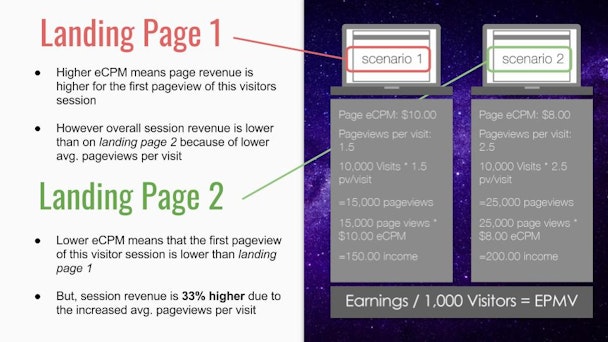The Publishing Industry Is Finally Adopting EPMV (or Session Revenue) and It’s About Time
The face of digital publishing is in constant change. There’s never been a time where publishers have had a more difficult array of parties to please. They’re finding themselves in a balancing act that requires them to consider the duopoly, advertisers, visitors, and profits all at once.

The Publishing Industry Is Finally Adopting EPMV (or Session Revenue) and It’s About Time
That’s why there’s been a recent surge of publishers changing their primary metric for measuring and optimizing revenue to EPMV (earnings per thousand visitors) — also referred to as session revenue. EPMV is a metric that accounts for the total value of a visitor session/visit; not just the value of a singular ad position or pageview.
Measuring total visitor value vs. ad value
EPMV allows the publisher to fully understand the impact that things like disruptive ad experiences or changes in a pages layout or navigation may have on the total amount of revenue generated by a readers entire visit. For example, loading a page full of ads may make individual page revenue go up, but total revenue go down because the visitor may leave prematurely — without visiting additional pages that could have accrued revenue.
The concept of measuring total session revenue has been around the app and gaming world for a long time. “Major app developers refer to this concept as ARPU — or average revenue per user — it basically demonstrates that overall session length and user value are inexorably tied, and we find this to be overwhelmingly true”, said John Cole, Chief Customer Officer of Ezoic.
Visitor experience is directly tied to revenue
We have done quite a bit of research on this subject; recently releasing several case studies on how things like ad density and navigation changes impact session revenue by visitor segment. “We’ve learned that if you understand what variables affect visitor behavior the most that you can have a pretty dramatic effect on the length of their session. The challenge is that every visitor is different”, Cole continued.
This was revealed in another study conducted by Ezoic that included four separate publishers that leveraged machine learning to see what different visitor segments preferred; and then adjusted every visitor session according to the data of previous look-a-like users. These Publishers included BrightHub, AppleToolBox, SimplyPsychology, and others.
Higher CPMs Do Not Equal Higher Revenue
One of the trends that seems to be losing steam amongst this surge from publishers to gather a better understanding of total visitor value is a decline in optimizing CPMs (cost per thousand impressions). While ad networks and other ad-tech businesses traditionally use this as a core metric, publishers have goals that are a bit different to the goal of advertisers.
A common misconception is that higher CPMs result in higher revenue. As demonstrated in EPMV example above, a page can have multiple ads with high CPMs on the page— resulting in a higher RPM or eCPM — but can be generating less revenue overall than pages with lower CPMs that deliver longer sessions with more page views.
A CPM measures the value of showing a single ad in a single location. However, it does not take into account the effect an ad has on user experience metrics (like page views / visit). If an ad provider doesn’t display per-user revenue – it could be because they don’t want the publisher to actually know how a certain ad impression might impact the visitors experience and overall revenue.
How to measure EPMV on your site
EPMV is a pretty simple metric to calculate. Publishers just have to take their total revenue for a certain time period divided by a thousand visitors (and they can do this by landing page, visitor segment, traffic source, etc.). This will provide the total session earnings per thousand website visitors.
Earnings / 1,000 visitors = EPMV
Many platforms have started to adopt EPMV and advocate for its widespread adoption; including Ezoic — which provides it in their free analytics tool —and other large publishing groups, like LION Publishers. As publishers are forced to balance more revenue streams, like subscriptions and affiliate earnings, it is likely that more and more attention will be turned to understanding total user value in the coming year.
Tyler Bishop, Head of Marketing, Ezoic
Content by The Drum Network member:

Ezoic
Find out more